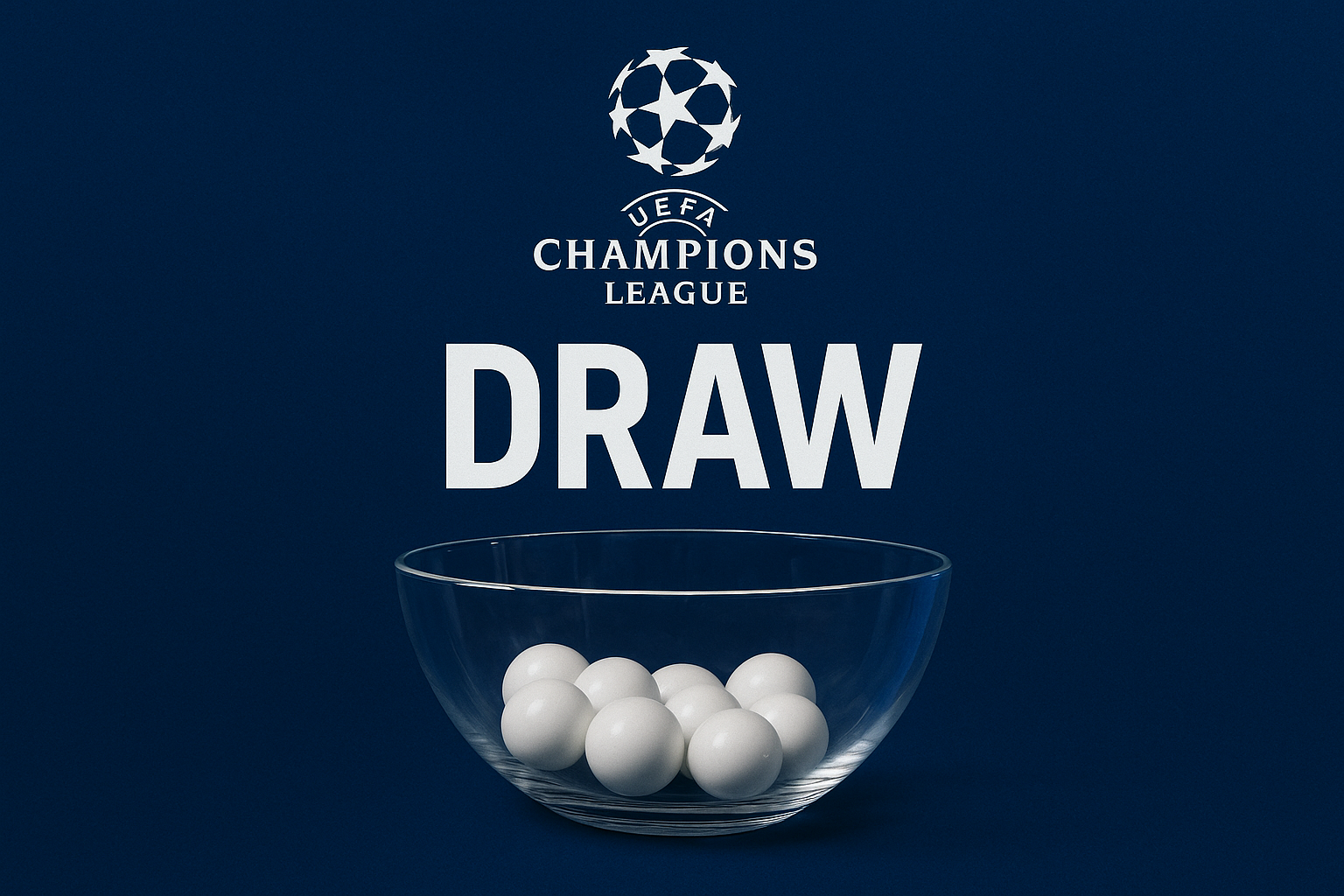UEFA Champions League 2025/26 League Phase Draw: Anticipation Builds for a Thrilling Season
The UEFA Champions League, Europe’s premier club competition, is set to captivate football fans once again with its 2025/26 edition. As the draw for the league phase takes place today in Monaco, excitement and speculation are at fever pitch. This season marks the second year of the revamped format, often dubbed the “Swiss model,” which promises more matches, greater unpredictability, and intensified rivalries. With 36 teams vying for glory, each club will face eight opponents in a single league table setup, replacing the traditional group stages. This change ensures top teams clash earlier and more frequently, heightening the drama from the outset.
For those unfamiliar with the format, the league phase places all 36 teams into one big league, where each plays eight fixtures—two against teams from each of the four pots, one home and one away. The top eight advance directly to the round of 16, while those ranked ninth to 24th enter a playoff round for the remaining spots. The bottom 12 are eliminated. The league phase extends into January, culminating in a synchronized final matchday on January 28, 2026, where all games kick off simultaneously for maximum suspense. The draw, scheduled for 5 p.m. UK time (midday ET), will determine these matchups, with rules to avoid same-country clashes and ensure balance.
The pots for this year’s draw have been finalized after the playoff rounds. Pot 1 features the elite, led by defending champions Paris Saint-Germain, who claimed their first title last season. Joining them are powerhouses like Real Madrid, with their record-extending triumphs; Manchester City, England’s dominant force; Bayern Munich, a perennial threat; Liverpool, revitalized under new management; Inter Milan, Serie A winners; Chelsea, blending youth and experience; Borussia Dortmund, known for their attacking flair; and Barcelona, aiming to reclaim past glory despite financial challenges.
Pot 2 includes established giants and rising stars. Arsenal, who impressed last season, headline this group alongside Bayer Leverkusen, the unbeaten Bundesliga champions of 2023/24. Atletico Madrid bring their gritty style; Benfica add Portuguese flair; Atalanta, surprise Europa League winners, continue their rise; Villarreal offer Spanish tactical nous; Juventus return with ambition; Eintracht Frankfurt represent German efficiency; and Club Brugge provide Belgian underdog spirit.
Pot 3 is packed with potential giant-killers. Tottenham Hotspur, under Ange Postecoglou, aim to build on domestic form; PSV Eindhoven, Dutch champions, boast technical skill; Ajax seek a revival; Napoli, post-Scudetto, retain star power; Sporting CP, led by Ruben Amorim, are tactically astute; Olympiacos bring Greek passion; Slavia Prague represent Czech resilience; Bodo/Glimt, Norway’s sensations, punch above their weight; and Marseille add French intensity.
Pot 4 rounds out the field with diverse clubs, many making rare appearances. FC Copenhagen from Denmark, AS Monaco with their flair, Galatasaray’s Turkish fervor, Union Saint-Gilloise as Belgian dark horses, FK Qarabag from Azerbaijan, Athletic Club’s Basque pride, Newcastle United’s Premier League energy, Pafos from Cyprus, and Kairat Almaty from Kazakhstan—all eager to make their mark.
Pots are determined primarily by UEFA club coefficients, with the Champions League holders automatically in Pot 1. Unlike before, Pot 1 offers no major advantage, as teams draw opponents from their own pot too. A key rule prevents same-nation clashes, adding complexity—especially for England, with six teams across the pots. Non-English Pot 1 teams must be paired with two Premier League sides for fairness.
Speculation swirls about dream and nightmare draws. England’s six clubs—Manchester City, Liverpool, Chelsea, Arsenal, Tottenham, and Newcastle—are in focus. Best-case scenarios might include lighter opponents like Dortmund, Villarreal, Pafos, or Kairat for top seeds, while worst-case could pit them against PSG, Barcelona, Napoli, or Union Saint-Gilloise. Manchester City, chasing consecutive titles, would relish home ties against Real Madrid or Bayern but might struggle away at PSG. Liverpool could hope for winnable home games against Inter or Dortmund, avoiding tough away trips to Juventus or Atletico. Chelsea’s young squad might benefit from Benfica or Atalanta, but Napoli or Marseille away could expose weaknesses. Arsenal, in Pot 2, could land glamour ties like Real Madrid at home or Bayern away. Tottenham, in Pot 3, might face PSG or Barcelona, thrilling their fans. Newcastle, in Pot 4, could fancy mid-tier teams but dread long trips to Olympiacos or Slavia Prague.
Beyond England, narratives abound. Real Madrid, now with Kylian Mbappe, could face PSG in a blockbuster reunion. Barcelona’s financial constraints make every point vital, and draws against Leverkusen or Juventus could define their campaign. Bayern, with Harry Kane, aim to dominate, but Napoli’s Victor Osimhen poses a threat. Italian sides—Inter, Atalanta, Juventus, and Napoli—could create sub-rivalries through third-party matchups.
Lesser-known teams like Pafos, Kairat Almaty, and Qarabag add unpredictability. Bodo/Glimt could stun a giant like Manchester City on a cold Norwegian night. Galatasaray’s raucous home crowd might unsettle Liverpool or Chelsea. These underdogs, from emerging football nations, have a chance to write Cinderella stories.
Historically, the Champions League has delivered iconic moments—from Liverpool’s Istanbul miracle to Real Madrid’s La Decima. The new format, with 189 games across league and knockout phases, ensures more revenue and exposure. Critics say it favors elites, but it also forces big teams to compete earlier, leveling the playing field.
The league phase begins September 16-18, 2025, with matches across Tuesdays, Wednesdays, and Thursdays to avoid other UEFA competition clashes. Knockouts start in February, leading to the final at Budapest’s Puskas Arena on May 30, 2026. PSG enter as favorites, but surprises are likely with the expanded field.
Analysts predict Premier League dominance due to England’s coefficient strength, while others see a Spanish resurgence with Real, Barcelona, Atletico, Villarreal, and Athletic Club. German teams—Bayern, Dortmund, Leverkusen, and Frankfurt—form a strong bloc, and Italian clubs could thrive in tactical battles.
For fans, the draw is the starting gun for months of drama. Will we see early classics like Manchester City vs. Real Madrid? Or upsets like Pafos shocking Arsenal? Social media buzzes with predictions, from easy away days to grueling trips to hostile venues.
The 2025/26 UEFA Champions League league phase draw is more than a procedural event—it’s the spark for a season of passion, strategy, and spectacle. As the balls are drawn in Monaco, millions will tune in, dreaming of glory. Whether your team lands a favorable path or a gauntlet of giants, European football’s crown jewel promises a campaign for the ages. Stay tuned for the results and let the games begin!
By Tony Nyanduse, Sports Writer at Street.co.ke

